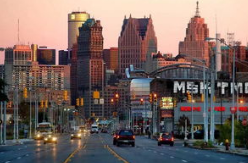Smaller is more beautiful
更小,却更美丽
Many other cities are battling problems almost as acute as Detroit’s
很多其他城市正在积极应对和底特律一样急迫的问题
THE five kinds of heirloom tomatoes on Joanna Lehrman’s and Roxanne Adair’s farm look delicious. Their tiny two-acre (0.8 hectare) farm also has a buzzing beehive and a hoop house, which protects produce in the winter. It is just a short walk from downtown Flint, a gritty struggling Michigan city. Until about a year ago the land was 16 abandoned residential lots along Beach Street, filled with rubbish, broken pieces of concrete and burnt trees. According to Doug Weiland, who runs the Genesee County Land Bank, a third of all Flint’s parcels are abandoned. Even seemingly stable neighbourhoods have boarded up houses.
在琼娜-勒曼和洛克森-艾黛儿的农场种植的五种看起来非常好吃。除此之外,在他们的农场里还有一个嗡嗡作响的蜂巢和冬天保护作物的大棚。从弗林特 – 一个在密歇根州常年与风沙作战的城市的闹市区到他们面积约两英亩(合0.8公顷)的小型农场只要走很短的一段路。直到一年以前,这块地还是沙滩街边上16个废弃的住宅用地,上面堆满了垃圾,破碎的混凝土块还有烧焦的树干。据乔纳斯郡土地银行的经营者道格-维兰德说,弗林特三分之一的土地被荒芜了。甚至看起来稳定的区域房子也被钉上了木板封起来了。
Flint is one of many cities in America’s rustbelt, like Detroit, Cleveland, Buffalo, Pittsburgh, Youngstown and Rochester, which have seen dramatic drops in population over the past half century or so. When manufacturing left these cities, so did their residents. In 1968, General Motors, which was founded in Flint, employed 80,000 employees there. Today, there are only 6,000. The city’s population has halved since 1960, falling from 197,000 to just over 100,000; proportionately, it has suffered nearly as badly as Michigan’s largest city, Detroit. Many unable to sell were forced to abandon their houses. Others lost their homes to foreclosure. The rustbelt cities of the Midwest and north-east have been in decline for decades, but it has taken decades for many of them to accept that no one was coming to save them.
弗林特是处在锈带的众多城市的其中之一,其他城市像底特律,克里夫兰,水牛城,匹兹堡,杨斯敦和罗切斯特,都在过去的大约半个世纪内,经历了人口大幅下滑。随着制造业离开了这些城市,城市的居民也随之离开了。在1968年,通用汽车在弗林特,也就是它成立的地方,雇佣了80000名员工。而今天,只剩下了6000名。城市的人口数相较于1960年的197000己经下降了一半,至100000出头。与此相类似的是密歇根最大的城市底特律,它的情况一样糟,许多人卖不出被强制将房子闲置。另一些人失去了他们的家并丧失了赎回权。中西部和东北部的锈带城市在过去的几十年里都有不同程度的衰落,但是他们花了几十年才接受这样一个事实,即没有人会来拯救他们。
These cities—many with acres of abandoned property—are finally and desperately trying to come up with stabilising plans. This is no easy task with a poor, ageing and dwindling tax base, expensive health and pension legacy costs, reduced commercial activity, high unemployment and high crime. Some of the problems of shrinking cities are so fundamental that there is no quick fix. For instance, the need to diversify was long ignored. Many of the rustbelt’s cities were single industry towns. Some were single company towns, like Kodak in New York’s Rochester or GM in Flint.
这些有着大量闲置土地的城市拼命努力要想出稳定计划。这在当前不良,陈旧,萧条的税务基础,昂贵的医疗和退休及遗赠成本,萎靡的商业活动,高失业率和犯罪率的情况下并不是一件容易的任务。这些萎缩城市的一些问题是那么地基础以至于不能够很快地得到解决。譬如说,多样化的需要一直被忽略。很多锈带城市属于那种单一的工业城镇。而一些则是属于单一公司的城镇,像柯达所在的纽约罗切斯特或是通用汽车所在的弗林特。

Flint is in the middle of developing a 20-year master plan, the first since Jack Kennedy was in the White House. The old thinking was to sell tax-foreclosed property to whomever, even speculators. The new thinking is that land is an asset for the city. Since its creation in 2002, the Genesee County Land Bank has had the power to take control of and to redevelop vacant, abandoned or tax-delinquent properties. Neighbours are encouraged to buy abandoned adjacent property for as little as $50. Alternative land use is encouraged. Ms Adair and Ms Lehrman own three of their farm’s lots, which they bought for $100 each from the Genesee County Land Bank. The rest they lease. The land bank has been a model for other cities and states, like Ohio and Georgia. Just this summer, Andrew Cuomo, New York’s governor, signed a bill allowing land banks.
弗林特正在制定一个20年的总体规划,这也是自从肯尼迪入主白宫之后的第一次。老的想法是把那些没收的房产卖给任何想买的人,即便是投机商。而新的想法是,土地是城市的财产。自从2002年成立以来,乔纳斯郡土地银行就拥有权力控制并再发展那些 空置的,废弃的,或是因未缴纳地税而被没收的地产。邻居们被鼓励以至少50美元的价格购买边上被闲置的地产。将这些地产挪作他用也是被鼓励的。艾黛儿女士和勒曼女士拥有构成她们农场地块中的三块,其中每一块都是她们花了100美元从乔纳斯郡土地银行购取的,余下的土地则是租赁的。这家土地银行已经成为其他城市和州(例如俄亥俄和佐治亚)的一个榜样。就在这个夏天,纽约州长安德鲁-郭沫签署了允许土地银行存在的法案。
Pittsburgh is often pointed to as a model for other shrinking cities. Its revival since its steel industry collapsed in the early 1980s is partly thanks to good long-term planning. Under the leadership of Tom Murphy, a three-term mayor, more than 1,000 acres of abandoned, blighted industrial land in Pittsburgh was cleaned up and is now thriving commercial, retail, residential and public space. Once lined with factories the city’s waterfront has been given over to parks. Mr Murphy oversaw the development of more than 25 miles of new trails alongside the river and urban green space. He helped develop public-private partnerships which leveraged $4.8 billion in economic development.
匹兹堡通常被指认为是其他萎缩城市的一个榜样。它的重整旗鼓要追溯到80年代前期,也就是其钢铁工业溃败的开始。这也要归功于一个好的长期计划。在连任三届的市长汤姆-莫非的领导下,匹兹堡超过1000英亩废弃的衰落的土地被清理干净,今天它们以商业区,零售店,住宅区和公共用地的方式兴盛着。曾经林立着工厂的滨江区现在让位给了公园。莫非先生监督了超过25英里的河边小道以及城市绿地的建设。他帮助建立了公共-个人的关系体系,这也让他借到了48亿美元用于经济建设。
As well as land, there are other assets, such as institutional “anchors”, even in the poorest of cities. Anchors can be hospitals and universities, arts organisations, and foundations (the Mott and Ford Foundations have been especially helpful to shrinking cities). Cleveland has its famous Clinic. Detroit Medical Centre, the Henry Ford Hospital and Wayne State University provide the same service for Detroit (see article).
和土地一样,就算是最穷的城市也有其他的财产,像一些机构的“锚”。这些锚可以是医院和大学,艺术机构和基金会(莫特和福特基金会对萎缩城市的帮助特别大)。克里夫兰有其有名的医疗服务。底特律医学中心,亨利-福特医院和韦恩州立大学为底特律市提供同样的服务。
Changing attitudes is essential. The American Assembly at Columbia University, which recently published a report on post-industrial cities, used the term “legacy cities” as “shrinking” and “resizing” can have negative connotations. Youngstown, a steel town, was devastated when its mills closed: over 30 years it lost more than half its population and thousands of jobs. It adopted a plan in 2005 which demanded accepting it is a smaller city. This is crucial, says Dan Kildee of the Centre for Community Progress. “Then you can get people’s minds to focus on what’s next and not what has been lost.” And there is hope. Bruce Katz of the Brookings Institution has long believed these cities will once again be the engines of their regional economies. Pittsburgh, for instance, reinvented itself as a successful tech and health hub, even as its population continues to fall. As Aristotle put it, “a great city should not be confounded with a populous one.”
改变态度是必须的。哥伦比亚大学的美国集会最近发表了一则后工业城市的报告,其中使用了“遗留城市”。因为“萎缩”和“尺寸调整”可能会有负面的涵义。钢铁城市杨斯敦在工厂关闭之后就荒芜了:在超过30年的时间里,它的人口数下降了一半以上,损失了数以千计的就业岗位。它在2005年采用了一项计划,该计划要求它必须接受这样一个事实,即它不再像过去那么大了。这是很关键的,社区发展中心的丹-基尔迪说“这样你就能让人们把焦点移到什么是接下来要做的而不是我们损失了什么。”希望是有的。布鲁金斯学院的布鲁斯-凯兹一直相信这些城市将会再次成为区域经济发展的引擎。举例说,匹兹堡已经转型成为一个成功的科技和健康医疗中心,即使是在人口持续下降的情况下。就像亚里士多德说的“伟大的城市不一定是人口多的城市。”
来源:经济学人

参与评论